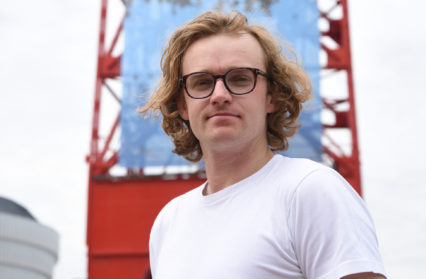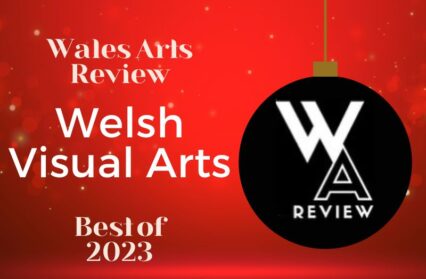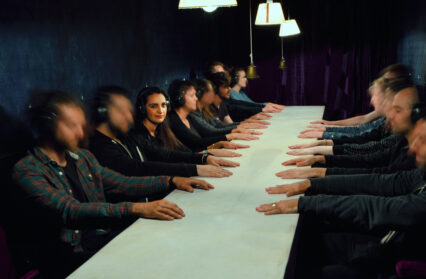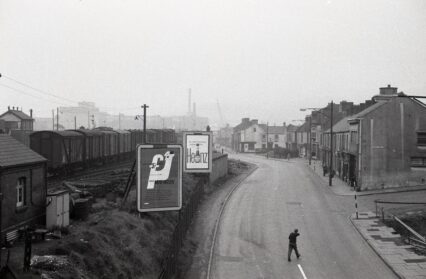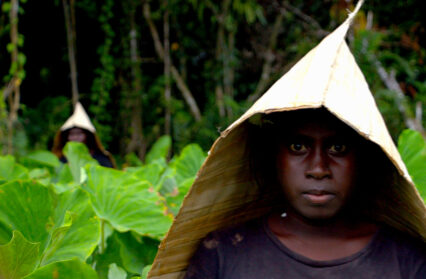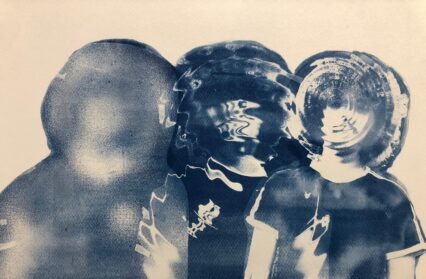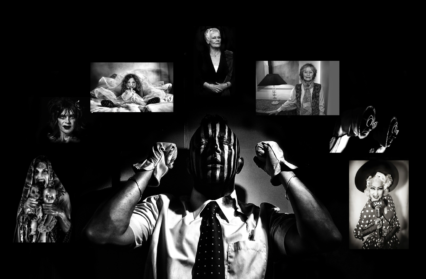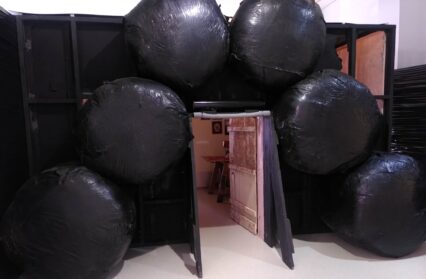Swansea artist Alexander Duncan brings together sculpture, new media and print, to question what is real and what is constructed. The artist explores the materiality of objects, the physicality of their being, and their semantic language. For Duncan, there is no such thing as an innocent object devoid of meaning; once an object is happened upon, it becomes an event of heightened perception and narrative.
Duncan has recently opened his first International Solo Exhibition ‘blow in’ at Aldama Fabre Gallery, Bilbao, Spain. Here he speaks with curator Emma Kelly about his studio practice and the ideas that formed this new body of work.
Emma Kelly: Here we are, sat in Aldama Fabre Gallery’s new space in the arty San Francisco area of Bilbao where you are launching your first International Solo Exhibition ‘blow in’. What informed the ideas for the show?
Alexander Duncan: From my initial research trip in February, the strength of ‘Basquness’ and the city’s dual identity was evident, so the exhibition began with an idea of creating work as someone from outside looking in. The term ‘blow in’ is often used as a derisory gesture; the idea of someone, in effect, blowing into a space as an artist was very interesting to explore. I wanted to own that identity and explore how ideas surrounding my practice could translate beyond language, to try to find more universal gestures.
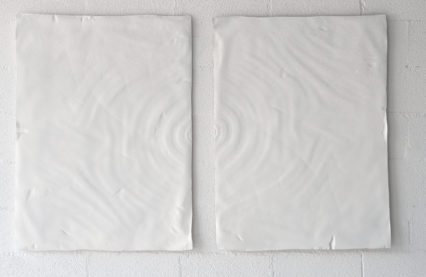
You have created some ambitious new work especially for the show here in Bilbao. Tell me how did the city itself shape your practice?
At the point of my early studio practice, I really hoped visiting Bilbao would generate new ideas of ways I could work. I think you can get very bottlenecked into the way you start making. Sometimes it is a new experience that is needed; travelling to a new city opens our eyes to different contexts, textures and day-to-day life.
The ideas surrounding the new relief pieces (relief (poster), 2017 and relief (notice), 2017) developed from the visual language of the city. I was fascinated by the surfaces that define public space like the many posters, flyering, and colourful murals that line the streets, this melting amalgamation of layers. So I began thinking how something like that could translate into new work that would also weave connections with existing work.
Considering Bilbao’s relationship to its water, I knew there was a relationship building around the idea of including ‘like swimming 2015-2017’ in the show. Water is a transient thing that can cut across – as water does – different languages. It is beyond the small things in life, and is at the center of Bilbao’s industrial past and relatively recent regeneration.
When considering creating a body of work to bring together, I needed to find work that could rebound but also use different surfaces. In my studio I began exploring new materials, beyond concrete, but exploring porcelain and surf wax – materials, which are not always ‘artwork’ materials, have a similar connection to recreation, re-creation, and the way people experience the world. ‘like swimming’ is quite a whimsical yet melancholic piece at the same time.
Let’s speak about the importance of the body relating to your work.
I was really interested in the swimming floats’ marks, scratches and bites, which suggest a childlike connection to play but also to fear and anxiety. The floats are borrowed from my local swimming pool, cast and colour matched then returned, with each one having a one-off re-creation. Similar ideas are present in the ’hold down (off Biscay)’ video, which suggests people being lost / sucked into something. The fun of having a GoPro video attached to your body whilst surfing (giving a ‘POV’ view of events) is elongated, focusing on a point where the wearer is underwater having lost control of the situation and is being tossed around uncontrollably in the washing machine of a rolling wave.
There is also a connection to the politicised and melancholic figures in water?
Yes, floats are a buoyancy. In today’s society, migration is a constant and the image of buoyancies feature often in contemporary media. To float becomes a political act: to be off somewhere, to be floating near something, to be in transit and off the edge. My titles are always ‘off’ the land or off something else, for example ‘hold down (off Biscay)’. So it is in the water, not on the land, and it is off the body.
The human connection is also readable in works like ‘surfer’s ear’. It is a replica, but not a straight replica; a solid earplug is as useful as a concrete float. There seemed something special in the elemental idea about denying a sense with quite a meticulously carved object. The work is hand carved from a found whale ear bone, I was hoping by using this material it would allude to the unknown effect that oceanic noise pollution has on a mammal’s communication. It was also the only part of the whale that would survive the smelting process.
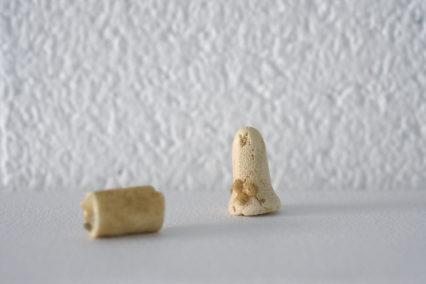
The title refers to surfer’s ear growth yes?
Yes, overexposing yourself to cold water can cause a bone to grow out of your ear, which is big enough to block your ear canal. I think it is very niche, but it is a niche area that I know well from surfing South Wales, I have had friends who’ve suffered from it. The bony growth is something they’ve recently found in ancient skeletons that adds to the alternative ‘aqautic ape theory’ championed by writer Elaine Morgan. All these different languages and materials are potent and something I always wanted to find a way of working into my practice, without being too obvious.
By substituting the natural for a man-made equivalent, your work highlights the complexities of contemporary experiences of real and fake. How do you approach the materials used?
I trial various materials in my studio. I originally made concrete cast earplugs with tiny casts, but the language felt wrong. It needed something different. So through working with the same netsuke carver I collaborated with for the work ‘netsuke’, I came upon this idea of it being a specific whale ear bone material. Upon researching the idea of the whale ear bone further, things linked together and it made sense.
Immersing yourself in the city and your workspace and its elements soon piece together if you are thinking about them all the time. Similarly with the surf wax cast of my studio’s ceiling (The texture is like that of an open ocean swell, something you might see from an airplane) takes me back to my bedroom ceiling when young. These things you remember.
Your latest work also sees you experimenting with printmaking, as seen in your series of float prints ‘like swimming (red room)’. How have you found this working in this medium? Can you tell me more about the sub title ‘red room’ here.
Making these works followed a similar idea to the cast floats with a desire to present the primitive marks that document hidden unseen events. They began with an excitement to experiment; maybe subconsciously there was this idea of printing as idea of an immediate mark. There is something wonderful and immediate about using a float as a block print, as something to leave a imprint. A ‘red room’ refers to a mythical unseen space on the dark web, where people have found it hard to prove its existence or verify that it is a false entity.
Will the work inspired by Bilbao continue once you return to the studio in the UK?
Yes, I feel like a I have touched on starting points for new work. I may look back in a year and think they are awful – but right now it feels great to be exploring new materials. With the reliefs, they started with the simple liquidity of material, which is something I am always fascinated with. They have a certain harmony, enough detail and impact that offer an interesting cross connection between the white objects, yet something that can sit in a space with a kaleidoscopic drift of floats.
Let’s talk influences? Are there any artists or places that influence your practice?
Guiseppe Penone is someone I grew up admiring, discovering the Arte Povera movement through artist like Tim Davies when I was in college, their poeticism with materials has always fascinated me. A simplicity and rawness of making work- to keep the object as something fascinating in a time when objects are deemed to hold less and less relevance.
At the RCA artists like Richard Wentworth, Densie De Cordova and Jordan Baseman were really supportive as lecturers, and my contemporaries in those years on the Sculpture course are working on some really exciting work, which is always inspiring to see. I came from an area where landscape is dominated by the elements (Alex grew up in Swansea), then moved to a city where it is dominated by people and architecture. Architecture is an amazing effecting thing when you are immersed in it, like the sea when I was younger. Having spent time in between London and Wales you see the cross over of the very different things that are a dominating factor in a space.
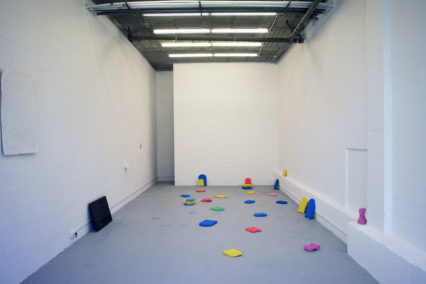
There seems to be many exciting Contemporary artists coming out of Wales today, James Richards at Venice Biennale this year.
Yes, Cerith Wyn Evans work at Tate Britain and Bedwyr Williams work at the recent Artes Mundi in Cardiff was as inspiring as ever. I’m really looking forward to seeing James Richards’ work, his collaboration with Chapter in Cardiff sounds great as they always have an exciting programme. I think as an idea of what you can bring to culture as a Welsh artist its really interesting striking a balance between looking out and inwards at same time, of opening things out for a discussion.
Parallel to the exhibition, you are presenting an ambitious new project suspended on Bilbao’s iconic La Carola Crane. How did you approach the commission?
La Carola has a very certain place in the landscape of Bilbao; speaking to locals it feels like the crane represents pre–Guggenheim, pre-revolution of the city centre. It is a bastion of Bilbao – iconic for ideas of city and legacy. So I need to tread carefully in how any artwork could interact with the structure.– after all there is no competing with a 100 ton bright red crane.
The idea of the banner came about through collaboration with the Ria de Bilbao Maritime Museum and Bilbao Art District, who supported the commission. The potency of scale was very interesting and I wanted to use the idea of La Carola’s height to explore a sense of depth.
The work is inspired by the strong connection Bilbao has to the tidal river and through it beyond, the ocean. The resulting image you see is photograph taken of a side of a shipping container. I felt a connection of liquidity the more I walked passed it and thought it could be something. In flux and change, the back peeling of paint revealing different colours and layers, to me I suppose a thinness of time.
The dual reading of the work as something melancholic, of sinking or that of something energizing and immersive. The ideas of renewal; to be within a material is something rare.
Alexander Duncan (Wales 1985) is a key emerging figure in Contemporary British sculpture. Duncan graduated in Fine Art from Swansea Metropolitan University in 2007 followed by an MA in Sculpture at the Royal College of Art, London, 2015.
He was a recipient of the Royal British Society of Sculptors Bursary 2015 Award and in the same year the Wakelin Award by Glynn Vivian Art Gallery, Swansea with two important works selected for their permanent collection.
He exhibits regularly and ‘cove’ is currently part of Offshore: Artists Explore the Sea at Ferens Art Gallery, Hull.
An important early work, first shown in Oriel Wrexham 2009 and since in various locations from Milan to the Whitechapel Gallery, London; ‘cove’ won the People’s Choice Award at the Lle Celf in the National Eisteddfod of Wales in 2012.
Duncan will be exhibiting at the Glynn Vivian Art Gallery, Swansea as part of Ephemeral Coast in January 2018.
Selected Solo Exhibitions: 2015 window project, Gazelli Art House, London; 2015 the Wakelin Award, Glynn Vivian, Swansea; 2012 raised beach, Mostyn, Llandudno; 2011 surge, Mission Gallery, Swansea; 2010 eocene Testbed, Oriel Davies Gallery, Newtown. Selected Group Exhibitions: 2017 Offshore: artists explore the sea Ferens Art Gallery, Hull; 2016 llanw Plas Glyn Y Weddw, North Wales; 2016 dip CBS Gallery, Liverpool; 2016 edge effects La Citadel, Mauritius; 2016 RBS Bursary Award, London; 2015 adjacent realities, Austrian Culture Forum, London; 2015 la biennale mediterrania 17 Milan, Italy; 2015 the bright field, OBS Gallery, Kent; 2015 London Open, Whitechapel Gallery, London; 2015 Open 19, MOSTYN, North Wales; 2015 N2, Platform One Gallery, London; 2015 Latching Firm, Camden Art Centre, London; 2014 Vulpes Vulpes Open, Bermondsey, London; 2014 Leicester Festival; 2014 As is the Sea, Hockney Gallery, South Kensington, London; 2014 Nocturne, Dyson Gallery, London; 2014 RCA @ ECA, Edinburgh college of Art, Scotland; 2013 Midden, Vulpes Vulpes, Bermondsey, London; 2013 IlfraExpo, Site related sculpture commission, Ilfracombe, Devon; 2013 Groundings, Alex Duncan and Ryan Moule, site-specific commission, Port Talbot; 2012 Y Lle Celf, National Eisteddfod of Wales; 2011 Locws International, Swansea.


